Physical Address
304 North Cardinal St.
Dorchester Center, MA 02124
Although most complications are avoidable, when they occur, rapid recognition and corrective response are necessary to mitigate adverse consequences such as myocardial infarctions or death.
Abrupt closure and intraprocedural stent thrombosis/acute stent thrombosis (<24 hours) are serious complications that can result in myocardial infarctions and death. Treating them requires rapid steps to restore perfusion, optimization of pharmacology, and careful evaluation to identify and treat the cause.
Coronary perforations are generally caused by guidewires, overdilation, and atheroablative devices. Sealing the perforation with balloon occlusion is imperative, followed by halting anticoagulation. Should it be necessary, either implantation of a polytetrafluorethylene (PTFE)-stent graft or referral to emergent cardiac surgery remains an option if the perforation persists.
Contemporary chronic total occlusion percutaneous coronary intervention (PCI) techniques involving subintimal dilation are associated with increased complication rates. Complications that were formally rare, such as intramyocardial hematoma, aortoostial dissection, and side branch loss, are surfacing more frequently at busy chronic total occlusion programs.
Stents embolization is an infrequent complication. If possible, retain wire access through the center of the stent. Retrieval involves an array of techniques, including distal balloon inflation, snaring, and wire wrapping. Deployment of an embolized stent in an unintended location may be necessary.
Emergent referral of patients undergoing PCI for cardiac surgery is associated with significant morbidity and mortality due to ongoing myocardial infarction and the powerful anticoagulants used during PCI.
Periprocedural myocardial infarction is associated with increased morbidity and mortality. Strategies to avoid periprocedural myocardial infarction include pharmacologic optimization and appropriate use of adjunctive devices such as distal protection filters.
Coronary no-reflow results when the distal microcirculatory bed is overwhelmed resulting in impaired coronary flow. Although sometimes reversible with vasodilators, prevention remains the best strategy.
Air embolism is almost always iatrogenic and preventable through meticulous catheter management.
Radiocontrast hypersensitivity occurs rarely and is sometimes difficult to recognize. Treatment with steroids and sometimes epinephrine may be necessary to stabilize the patient’s hemodynamics.
Bleeding is associated with significant in-hospital and 30-day mortality. Strategies to avoid bleeding include optimization of patient selection, pharmacology, and access site selection and management.
Over the past 40 years, complications of percutaneous coronary intervention (PCI) have decreased dramatically. The contemporary procedural risk of death, myocardial infarction (MI), or urgent referral for bypass surgery is 1.54% to 1.67%, 1.5%, and 0.2%, respectively. The lower complication rate is partially responsible for a growing trend towards same-day discharge following PCI. Nevertheless, prompt recognition of complications and a calm and effective response are essential components of success as a PCI operator. This chapter will explore the most common procedural complications .
The term abrupt closure dates back to the prestent era, referring to cessation of coronary flow often related to dissection or thrombosis. In contemporary interventional practice, vessel closure is a relatively rare event that may be related to inadequate pharmacology, residual thrombus, stent edge-dissection, or inability to contain a major coronary dissection. The incidence of abrupt closure (often called “acute closure”) during PCI has steadily decreased from 3% in the balloon angioplasty era to 0.3% in the current era ( Fig. 29.1 ). The trend in decreasing acute closure rates corresponds to the increased utilization of stents and effective antithrombotics, including glycoprotein IIb/IIIa inhibitors, dual antiplatelet therapy, and direct thrombin inhibitors. The decrease in abrupt closure resulted in a decrease in emergent coronary artery bypass grafting (CABG) and reduced periprocedural PCI mortality from 1.4% in 1985–1986 (as observed from the National Heart, Lung and Blood Institute [NHLBI] Dynamic Registry), to an in-hospital mortality rate of 0.13%–0.16% and 1.54%–1.67% for elective and all PCI, respectively, as a result of the most recent iterative improvements in technology and quality.
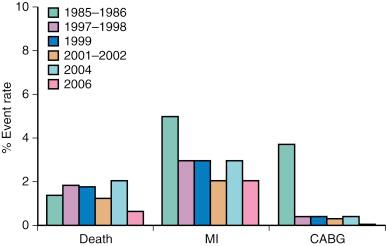
The most common mechanism of acute closure is dissection and injury to the media ( Fig. 29.2 ; Table 29.1 ). Intramural hematoma can develop, along with intimal flaps, causing mechanical obstruction. With mechanical obstruction and the exposure of subintimal tissue, thrombus formation is often initiated. Vasoconstriction further complicates this milieu but is rarely a major mechanism of closure.
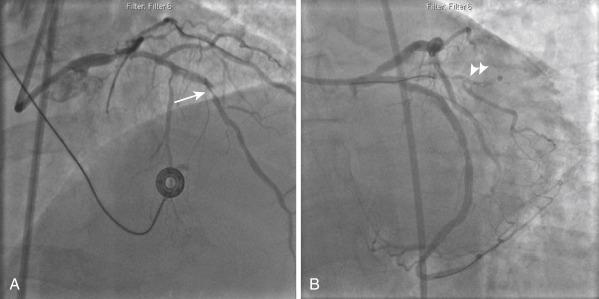
| Type | Description | Acute Closure (%) |
|---|---|---|
| A | Minor radiolucencies within lumen during angiography without dye persistence | 0–2 |
| B | Parallel tracks or double lumen separated by radiolucent area during angiography without dye persistence | 2–4 |
| C | Extraluminal cap with dye persistence | 10 |
| D | Spiral luminal filling defects | 30 |
| E | New persistent filling defects | 9 |
| F | Non-E types that lead to impaired flow or total occlusion | 69 |
Although the predominate causes of acute closure in the pre-stent era were dissection (28%), thrombus (20%), or both (7%), the cause is indeterminate in almost 50% of patients. Patient factors predictive of abrupt closure include unstable angina, multivessel disease, and female gender. When examining the angiographic risk factors of dissection-mediated acute closure, proximal tortuosity was the strongest predictor followed by American College of Cardiology (ACC) lesion grade C ( Table 29.2 ), longer lesion length, and de novo stenosis. Similarly, risks for thrombotic closure include presence of preexisting thrombus, degenerated vein grafts, and recent MI. Air embolism and no-reflow phenomenon are also part of the differential diagnosis of abrupt closure (discussed elsewhere).
| Type A |
|
| Type B |
|
| Type C |
|
As techniques in interventional cardiology have evolved to include intentional dissection and reentry for recanalization of chronic total occlusions (CTOs), the breadth of complications from dissections have changed. Formerly, there were concerns only of abrupt closure for untreated dissections; however, now that extensive dissections are created with the ultimate goal of successful recanalization and stenting along its entire length, the implications of dissections differ. The range of complications currently include abrupt closure of unstented dissections should the operators be unable to stent the length of the exposed subintima, propagation of subintimal hematomas that unintentionally extend the dissection, and stenting of the subintimal space unintentionally closing side branches resulting in ischemia or infarction.
Most data regarding outcomes of patients experiencing abrupt closure are derived from the prestent era. In studies from the balloon angioplasty era, 6% of patients died, 36% suffered nonfatal MI, and 30% were referred for emergency CABG.
Abrupt closure results in acute ischemia that may be manifested by dramatic electrocardiogram (ECG) changes, hypotension, hypertension, chest pain, ventricular arrhythmias, and/or bradycardia.
The first priorities are to stabilize hemodynamics and relieve ischemia. Vasopressors, inotropes, intraaortic balloon pump (IABP), or ventricular assist device insertion should be considered for hemodynamic instability. Extreme vagal reactions may also cause bradycardia or hypotension and should be treated with atropine, intravenous (IV) fluid boluses, and vasopressors if necessary. Immediate recognition and treatment of electrical instability with antiarrhythmic medications and cardioversion are imperative.
Expeditious efforts to restore antegrade flow such as repeat angioplasty must be quickly attempted. Urgent stenting is usually required to stabilize dissections. Glycoprotein IIb/IIIa or IV P2Y 12 inhibitors can be helpful if thrombus is responsible for the acute closure. Prospective use of abciximab was compared with placebo in both balloon angioplasty and stenting cohorts in the Evaluation of Platelet IIb/IIIa inhibitor for Stenting (EPISTENT) trial and demonstrated that abciximab decreased rates of abrupt closure and side branch loss. However, the utility of glycoprotein IIb/IIIa inhibitors as a bailout is controversial because the available data are more supportive of upstream use during PCI.
In the case of persistent acute closure, one should consider the use of intravascular ultrasound (IVUS) to better define pathology, such as the presence and extent of dissections. Multiple stents may be required to restore patency and stabilize a dissection. If the IVUS findings are suspicious for thrombus, aspiration thrombectomy may be valuable and the addition of a glycoprotein IIb/IIIa inhibitor should be considered. Intracoronary thrombolytic delivery has been used for rescue of abrupt closure but is associated with significant morbidity and not recommended. When wiring dissections, it is important to confirm selection of the true lumen prior to stenting or otherwise suffer the result of false-lumen stenting and loss of myocardial perfusion. In the process of troubleshooting the dilemma of true versus false-lumen location, IVUS can help to distinguish the two without potentially pressurizing the subintimal space with selective injections ( Fig. 29.3 ).
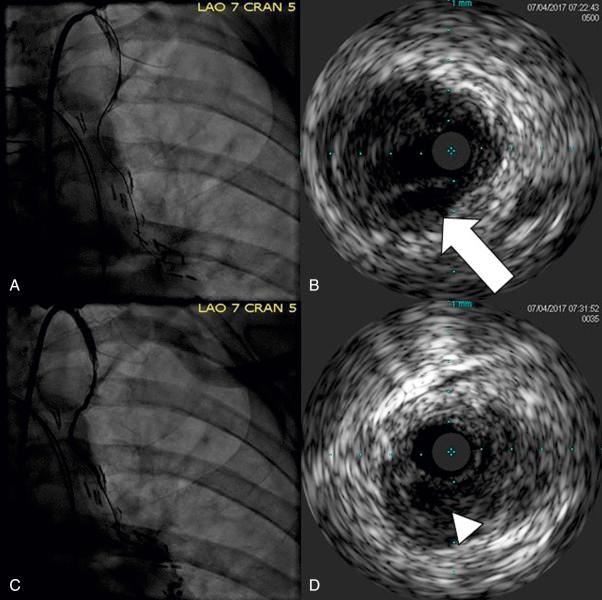
Factors affecting the inflow and outflow should be investigated. The use of multiple angiographic views, IVUS, and selective distal injections may better delineate the anatomy. Guide catheter dissections may cause poor in-flow and can easily be overlooked. Pressure dampening, ventricularization, ECG changes, or severe ischemic pain may indicate an ostial guide catheter dissection. Distal wire dissections that occlude outflow may require stenting or prolonged balloon inflation.
In the prestent, balloon angioplasty era, approximately 40% of cases with acute closure ultimately achieved procedural success. The predominant treatment was repeat balloon dilation with prolonged inflation facilitated by autoperfusion balloon catheters. Historically, the use of stents as a bail-out device for abrupt or impending closure dramatically decreased the need for emergent CABG. Although no randomized trial has been performed, the dramatic decrease in urgent and emergent CABG, from 3% to 0.7% in the NHLBI Dynamic Registry was clearly associated with the use of stents and more effective anticoagulation, primarily glycoprotein IIb/IIIa inhibitors and P2Y 12 inhibitors.
Patients with a successful outcome following treatment of abrupt closure require close monitoring in an intensive care setting. If needed, intraaortic balloon counterpulsation or left ventricular (LV) assist devices should be considered until the patient is stable. Serial cardiac enzyme assessments, ECGs, and echocardiography to assess the extent of myocardial damage are also recommended (see Fig. 29.4 for acute vessel closure management algorithm).
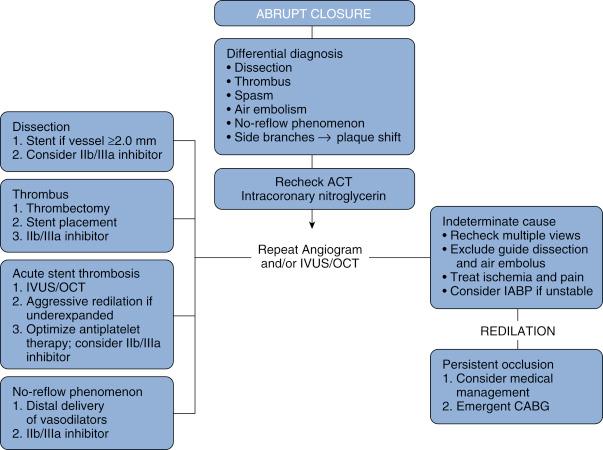
If recanalization is unsuccessful, the interventionalist is faced with the choice of referral for emergent coronary bypass surgery or medical management. Medical management is essentially acceptance that the patient will sustain an MI. The quantity of myocardium subtended by the closed vessel, versus the likelihood of a successful surgical result and risks of undergoing emergent surgery, is the most important factor when deciding between surgical or medical management of abrupt closure. Care must be taken to distinguish “refractory closure” from “no-reflow” because CABG is ineffective in the latter. Certainly the degree of supportive therapy may include use of devices to treat cardiogenic shock and utilization of percutaneous ventricular assist devices ranging from axial flow catheters (Impella, Abiomed, Danvers, MA) or extracorporeal support either in the form of TandemHeart (LivaNova, London, U.K.) or extracorporeal membrane oxygenation (ECMO).
Intraprocedural and acute stent thrombosis both comprise a form of contemporary abrupt closure. Stents serve to improve patency after dilating stenotic lesions and stabilize dissections, but metal is inherently thrombogenic, and early experience with stents showed thrombosis rates as high as 8% to 16% if implanted for rescuing abrupt closure. The early stent thrombosis (<30 days) rate for elective PCI in stable coronary artery disease (CAD) patients is 0.3% to 0.5%, but stenting for acute coronary syndromes demonstrated early stent thrombosis rates as high as 3.4% and 1.4% for ST-elevation MI (STEMI) and non-STEMI (NSTEMI), respectively, indicating the presence of a thrombogenic milieu. Intraprocedural stent thrombosis (IPST) and acute stent thrombosis are rare events, occurring 0.8% to 1.2% and 0.1% to 0.9% of cases, respectively. For purposes of this chapter, we will focus on intraprocedural and acute stent thrombosis (<24 hours from implantation).
Factors leading to stent thrombosis include a combination of patient comorbidities, suboptimal pharmacology, and procedural variables related to stent implantation, plaque disruption, and vessel injury. Multivariate analysis from the Cangrelor versus Standard Therapy to Achieve Optimal Management of Platelet Inhibition-PHOENIX (CHAMPION-PHOENIX) study identified NSTEMI and STEMI at presentation (NSTEMI odds ratio [OR] 1.87, P = .04; STEMI OR 2.07, P = .004), angiographic thrombus prior to PCI (OR 1.79, P = .01), and total stent length (OR 1.03 per mm, P < .0001) as independent predictors of IPST. Post hoc inspection of the Acute Catheterization and Urgent Intervention Triage Strategy (ACUITY) trial revealed insulin-dependent diabetes (OR 3.48), renal insufficiency (OR 2.09), Duke jeopardy score (OR 1.15), final stent minimal luminal diameter (OR 0.32 ), preprocedural thienopyridine administration (OR 0.30), baseline hemoglobin (OR 1.28), and extent of CAD (OR 1.01) as independent factors associated with early stent thrombosis. In an IVUS substudy of stent thrombosis from the Harmonizing Outcomes with Revascularization and Stents in Acute Myocardial Infarction (HORIZONS-AMI) trial, small cross-sectional area (<5 mm 2 ), stent malapposition, plaque protrusion, edge dissection, and residual stenosis played significant roles in predicting early stent thrombosis. All cases of stent thrombosis had at least one abnormality, and 50% of patients had two or more IVUS abnormalities. Ex vivo histologic analysis of fatal stent thrombosis cases corroborated plaque prolapse and incomplete apposition as contributors of stent thrombosis; however, medial tears were found in 27% of analyzed segments, suggesting that deep vessel wall injuries play a significant role in stent thrombosis. Finally, complex PCI, particularly stenting using the crush technique, carries a higher rate of IPST of 0.5% to 1.3%.
Mortality of stent thrombosis ranges from 26% to 45% overall when looking at all-comers. Those who present with STEMI are found to have less successful reperfusion compared with their STEMI counterparts who do not have stent thrombosis (stent thrombosis 80.4% vs. nonstent thrombosis 96.9%, P < .0001). Along with less successful reperfusion, those with STEMI in the context of stent thrombosis have greater rates of in-hospital mortality (stent thrombosis–STEMI 17.4% vs. nonstent thrombosis– STEMI 7.1%, P = .03) and composite major adverse cardiovascular and cerebrovascular event (MACCE) (stent thrombosis–STEMI 25.6% vs. nonstent thrombosis–STEMI 9.2%, P = .003). Similarly IPST has a 30-day mortality rate of 10.1% and carries an adjusted OR of 12.3 of death compared with non-IPST cases. In addition, IPST predicts a higher rate of 30-day post-PCI stent thrombosis (5.6%, adjusted OR 7.6).
Avoiding stent thrombosis requires operators to be meticulous about anticoagulation and stent implantation. A fundamental axiom is confirming adequate outflow prior to stent implantation. Placing a stent in an artery with no-reflow due to microvascular obstruction or a vessel with poor distal runoff is risky and may increase the likelihood of stent thrombosis. In the highest thrombotic risk acute coronary syndrome, STEMI, it appears that preprocedure pharmacology may be efficacious for reducing stent thrombosis. Preprocedure prasugrel did not seem to impact stent thrombosis and was associated with excessive bleeding complications; however, pre-hospital ticagrelor decreased definite stent thrombosis (OR 0.26, 95% confidence interval [CI] 0.07 to 0.91). Cangrelor utilization was associated with a 35% decrease in intraprocedural stent thrombosis (OR 0.65, CI 0.42 to 0.99, P = .04) in the CHAMPION-PHOENIX study, further emphasizing the important role of platelet blockade in stent thrombosis. Routine use of intravascular imaging has been shown to be important in left main stenting, and summated evidence from a recent meta-analysis shows a significant decrease in stent thrombosis when using IVUS and optical coherence tomography (OCT) with an OR of 0.42 (95% CI 0.2 to 0.72) and 0.39 (95% CI 0.1 to 1.20), respectively. When using IVUS, reductions in cardiovascular death, MI, and target-lesion revascularization were observed.
When confronted with acute or IPST, one must be very prompt at restoring perfusion to minimize myocardial damage and the approach to treatment should include both pharmacologic and mechanical optimization. Certainly, if intracoronary thrombus develops, prompt aspiration thrombectomy or angioplasty should be performed immediately to restore patency. Therapeutic anticoagulation should be confirmed and more potent antiplatelet therapy considered, as both IV cangrelor and glycoprotein inhibition were both associated with less IPST. Bailout glycoprotein inhibitor, loading with either prasugrel or ticagrelor, or switching to cangrelor to rapidly reach maximal steady state platelet inhibition may be helpful if not already using these medications. If there is suspicion the patient could have heparin-induced thrombocytopenia (HITT), switching to a direct-thrombin inhibitor such as bivalirudin should be considered. Intravascular imaging with either IVUS or OCT should be used to determine stent apposition, expansion, and presence of edge dissections. Optimization of stent deployment with appropriate postdilation and treatment of edge dissections with additional stents will be imperative to prevent repeat stent thrombosis. Additional stent implantation should be done judiciously because each millimeter of stent increases the probability of IPST.
Coronary perforation is a serious complication with an incidence ranging from 0.19% to 3.0% of cases ( Table 29.3 ). Lesions associated with perforation are more complex in nature. ACC type B or C, calcified lesions, or CTOs are more likely to sustain perforation (see Table 29.3 ). Women and the elderly are at greater risk of perforation. Since the introduction of CTO PCI, two multicenter registries have described a perforation rate of 0.33% to 0.34% of all cases and a prospective multicenter U.S. registry describes a 4.1% rate of perforations in a 5-year history of CTO cases.
| Author | Number of Procedures | Perforation Incidence (%) | Tamponade (%) | CABG (%) | MI (%) | Death (%) |
|---|---|---|---|---|---|---|
| Aljuni et al. (1988–1992) | 8932 | 0.4 | 17 | 37 | 26 | 9 |
| Dippel et al. (1995–1999) | 6214 | 0.58 | 22 | 22 | NA | 11 |
| Ellis et al. (1990–1991) | 12,900 | 0.4 | 24 | 24 | 16 | 5 |
| Fasseas et al. (1990–1991) | 16,298 | 0.58 | 11.6 | 10.5 | 12.6 | 7.5 |
| Gruberg et al. (1990–1999) | 30,746 | 0.27 | 31 | 39 | 34 | 10 |
| Gunning et al. (1995–2001) | 6245 | 0.8 | 46 | 15 | NA | 12 |
| Javaid et al. (1996–2005) | 38,559 | 0.19 | 19 | 35 | NA | 17 |
| Kiernan et al. (2000–2008) | 14,281 | 0.48 | 18 | 3 | 7.4 | 5.9 |
| Shimony et al. (2001–2008) | 9568 | 0.59 | 15.8 | 7 | NA | 7 |
| Stankovic et al. (1993–2001) | 5728 | 1.5 | 12 | 13 | 18 | 8 |
| Ramana et al. (2001–2004) | 4886 | 0.5 | 4 | 20 | 32 | 8 |
| Witzke et al. (1995–2003) | 12,658 | 0.3 | 18 | 5 | 5 | 2.6 |
There are two basic mechanisms of perforation: guidewire penetration and vessel rupture. Vessel rupture is usually caused by balloon or stent mismatch with oversizing of the dilatation catheter. Occasionally, an appropriate-sized balloon or stent will result in perforation due to extensive dissection, lack of vessel wall integrity, or subintimal wire placement. Early balloon angioplasty studies found increasing the balloon:artery ratio greater than 1.2:1 increased perforation risk. Use of atherectomy devices such as excimer laser or rotational atherectomy increases perforation risk as well. Recanalization of CTOs has become a common setting for perforation, sometimes due to small guidewire perforations; however, the increasingly aggressive maneuvers of high-pressure dilations and use of atheteroablative devices in the subintimal space have led to more frequent perforations.
Ellis graded perforations ( Table 29.4 ) by separating them into three classes of severity ranging from small endovascular leaks into the adventia (grade I) to frank extravasation into the pericardial space (grade III). Grade I perforations are frequently caused by guidewires but atheroablative devices and stents can cause small endovascular leaks. Occasionally, guidewires can cause very large distal perforations; therefore extreme vigilance should be maintained, particularly when using stiff and hydrophilic guidewires into distal tortuous vessels. Grade II and grade III perforations are usually caused by high-pressure balloon inflations, oversized balloon catheters, stents, the use of atheroablative devices, or aggressive interventions in the subintimal space ( Fig. 29.5 ).
| Classification | Description | Possible Clinical Sequelae |
|---|---|---|
| I | Focal extraluminal crater without extravasation limited to media or adventitia | Usually benign, may rarely cause delayed cardiac tamponade |
| II | Pericardial or myocardial blush without contrast in pericardium; limited extravasation producing patch of blushing or staining within the myocardium or pericardium | |
| III | Persistent extravasation with streaming or jet of contrast | High risk, increased morbidity and mortality |
| IIIA | Directed toward pericardium | High risk of acute cardiac tamponade |
| IIIB | Directed toward myocardium (e.g., ventricular cavity) | More benign course; possible fistula formation |
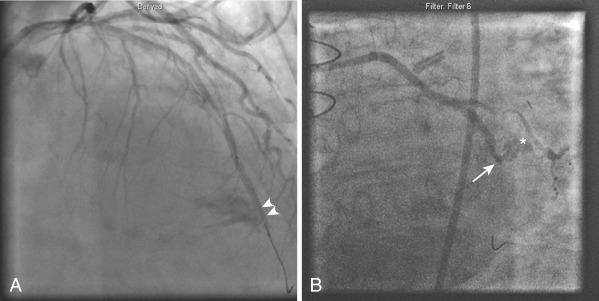
Perforation severity predicts prognosis. Grade III perforations can quickly result in cardiac tamponade, rapid hemodynamic collapse, MI, and/or death ( Table 29.5 ). Either immediate covered stent implantation or referral for emergency CABG is often indicated. With the dissemination of subintimal techniques for CTO PCI, perforation is associated with a 7.1% rate of death and 25.9% rate of major adverse cardiac events (MACEs). A legacy effect has been reported with a 1.6 odds for death at 12 months in perforation survivors of CTO PCI.
| Incidence (%) | n | Death (%) | MI (%) | CABG (%) | |
|---|---|---|---|---|---|
| Brilakis et al. | 0.32 | 38 | 3 | 11 | 5 |
| Bolte et al. | 1.7 | 387 | 6.2 | 3.9 | 17 |
| Cantor et al. | 8.3 | 108 | 2.8 | 5 | 16 |
| Eggebrecht et al. | 0.9 | 20 | 15 | NA | 15 |
Given the dire consequences of coronary perforation, the interventionalist must be especially attuned to recognizing this complication early. Patients may experience hypotension, severe chest pain, dizziness, or nausea disproportional to symptoms typically associated with balloon inflation. There may be persistent ST segment changes after balloon deflation. Vasovagal reactions may also accompany perforations along with severe bradycardia and hypotension. Awareness and vigilance post-PCI is vital because cardiac tamponade as late as 24 hours post-PCI has been reported. Perforations have been associated with a cardiac tamponade rate of 14.1% to 14.2% in two separate registries and 10% in the subset of CTO-PCI in post-CABG patients. Late tamponade risk can be minimalized with careful “final” angiograms visualizing all instrumented vessels and their branches.
Become a Clinical Tree membership for Full access and enjoy Unlimited articles
If you are a member. Log in here